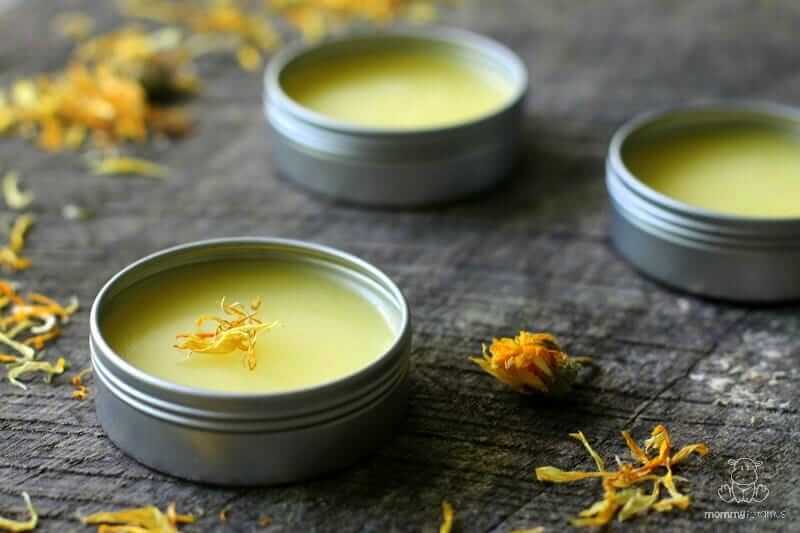
It’s the secret ingredient in many healing balms and skincare products, and for good reason. Calendula petals are rich in compounds that nourish, hydrate, and support skin healing, which is why they’ve been used for centuries to help with everything from pinkeye and sore throats to skin irritations. But don’t think you need a cut or scrape to make use of it – I apply it to my face and love the way it makes my skin glow!
A few weeks ago I shared two super simple methods for making calendula infused oil at home, and now I’m going to show you how ridiculously easy it is to make it into an #allthethings skincare salve. By #allthethings, I mean it can be used as a:
- face moisturizer
- chapped-lip balm
- baby bottom balm
- owie salve
- burn salve
- bug bite balm
Seriously, this stuff is so amazing I carry a little tin of it in my purse. These 2 oz. tins are the perfect container for it, plus other personal care products like this children’s chest rub and these bug repellent lotion bars.
They also make a gorgeous gift container for moisturizing lotion bars.
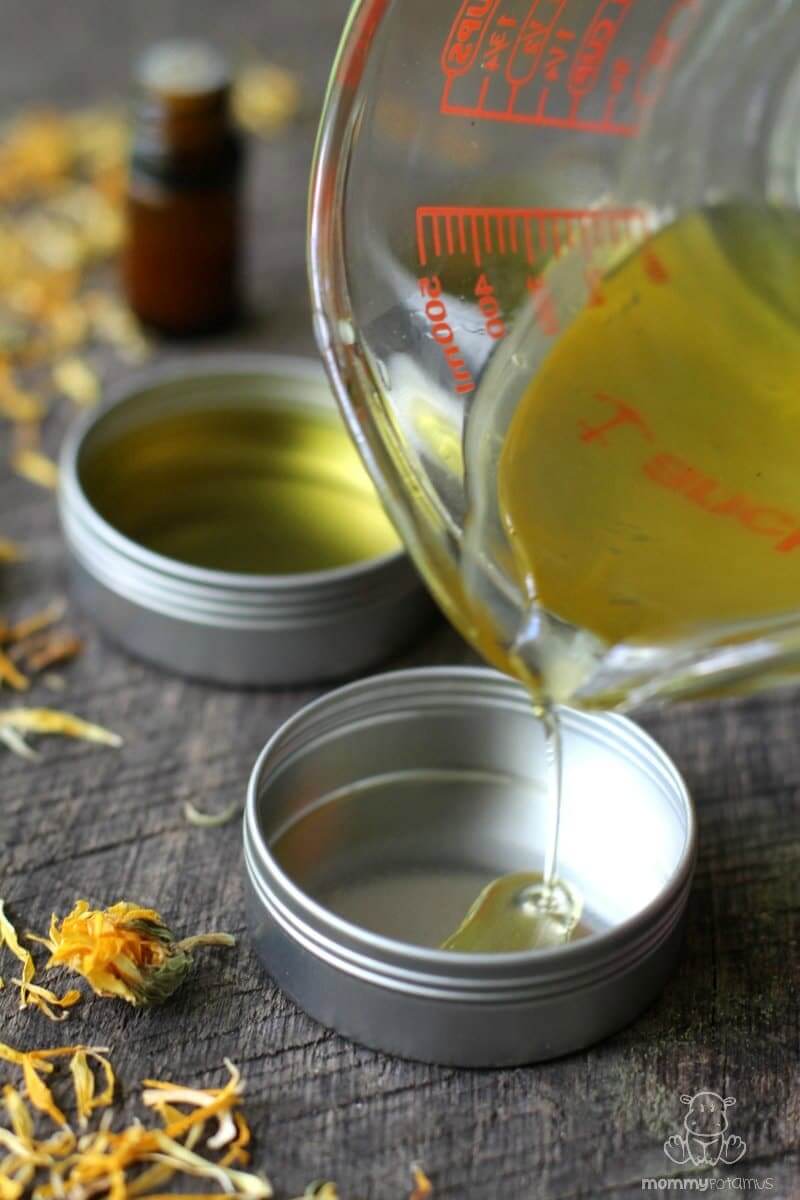
About The Ingredients
Calendula Infused Oil – Made by infusing calendula flowers into a carrier oil such as olive oil, jojoba oil, sweet almond oil, calendula oil can be used as a massage oil, a base for skin salves like this one. It can even be drizzled over salad if you use an edible carrier oil – olive oil is, while jojoba oil is not.
You’ll find two methods for making it here, but if you want to skip the infusion process, you can buy pre-made calendula oil here.
Beeswax – In addition to firming up the salve, beeswax helps skin by forming a protective barrier and helping to seal in moisture so that skin stays hydrated.
Essential Oils – I love the earthy, herbaceous scent of calendula, and truly it’s an ingredient that stands on its own. However, there are several essential oils that can be complementary based on what you are trying to achieve. A few of my favorites are:
- German chamomile(Matricaria chamomilla L) – Soothes congested skin. Also relaxing, helpful for sleep, and may support clear thinking when pollen counts are high
- Frankincense carteri (Boswellia carteri) – Used to support youthful looking skin and soothe cuts, bruises and other injuries. Relaxing and considered helpful for immune support.
- Frankincense frereana (Boswellia frereana) – Prized for its skin rejuvenating properties, frankincense frereana is also used for cuts, bruises and other injuries, nourishing mature skin, and supporting immune function.
- Lavender (Lavandula augustifolia)- Calming, helpful for soothing bug bites, sunburns, and other skin irritations
- Tea tree (Melaleuca alternifolia) – Helpful for cuts, scrapes, and supporting clear, smooth skin. Also considered supportive to the immune system.
- Carrot seed (Daucus carota) – Thought to be beneficial for supporting skin elasticity and healing. Most people don’t like its aroma, though, so I suggest blending it with another essential oil or putting it on at night just before bed. Safety note: Carrot seed oil is not recommended for mamas who are pregnant or breastfeeding.
DIY Calendula Salve Recipe
Ingredients
- 4 oz. calendula infused oil (you can make your own calendula oil using this recipe, or buy pre-made calendula oil here)
- ½ oz. beeswax (by weight, that's about 2 tablespoons of beeswax pastilles or grated, packed beeswax)
- 25-50 drops essential oil (optional – lavender, frankincense, chamomile, tea tree or carrot seed are good choices)
Instructions
- Gently heat the beeswax in a double boiler. If you don’t have a double boiler you can use a stainless steel bowl set inside a pot of boiling water.
- When the beeswax is melted, add in the calendula oil. Allow it to warm up for 30-60 seconds, then stir until the beeswax and oil are thoroughly mixed.
- Remove the mixture from heat. If you’re adding essential oils, wait until it cools just a little and then stir them in.
- Pour your salve into a clean, dry glass jar or container and allow it to cool. The recipe above makes three of these 2 ounce tins. Now you’re ready for the next bug attack, bee sting, scrape, etc.
Notes
More Herbal Oil Recipes
- Dandelion Oil – Like calendula, dandelions are a member of the Asteraceae family and are well-known for their skin-soothing benefits. During the spring and summer you can gather them for free to use in dandelion salves.
- Comfrey infused oil – Sometimes called knitbone or All Heal, comfrey has been used for centuries to support bone and wound healing. It’s also often used in skincare products due to its moisturizing properties.
- Plantain oil – Plantain is sometimes called the “band aid” plant because – thanks to the presence of iridoids – it has a very soothing, anti-inflammatory effect on skin. It also contains allantoin, which supports skin healing.
- Arnica Oil & Cream – Arnica has been traditionally used by Swiss mountaineers to prevent muscle soreness, and according to The New York Times, “scientists have found good evidence that it works.” When I injured my shoulder awhile ago, I made up a batch of arnica cream to use along with physical therapy. It was so helpful!
Want more research-backed natural remedies?
No problem, I’ve created a free ebook for you – Kitchen Apothecary: 25+ Natural Remedies Using Ingredients From Your Pantry – as a gift for signing up for my newsletter. You’ll also get updates when I post about safe essential oils for pregnant/breastfeeding mamas, exclusive gifts and coupons (I was able to give away a jar of free coconut oil to anyone who wanted it recently!), plus other goodies.
Sign up using the form below.

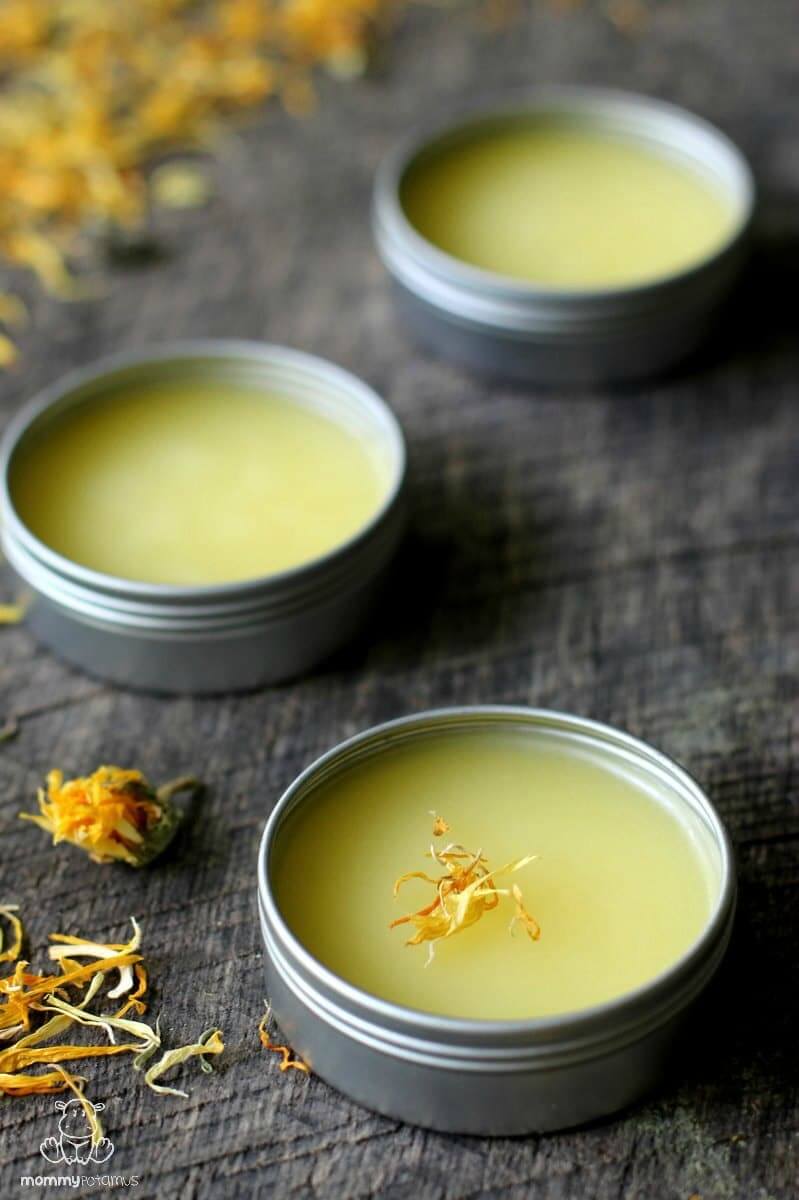
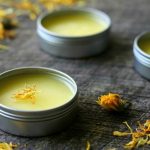
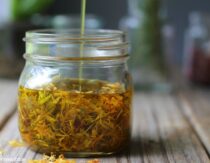
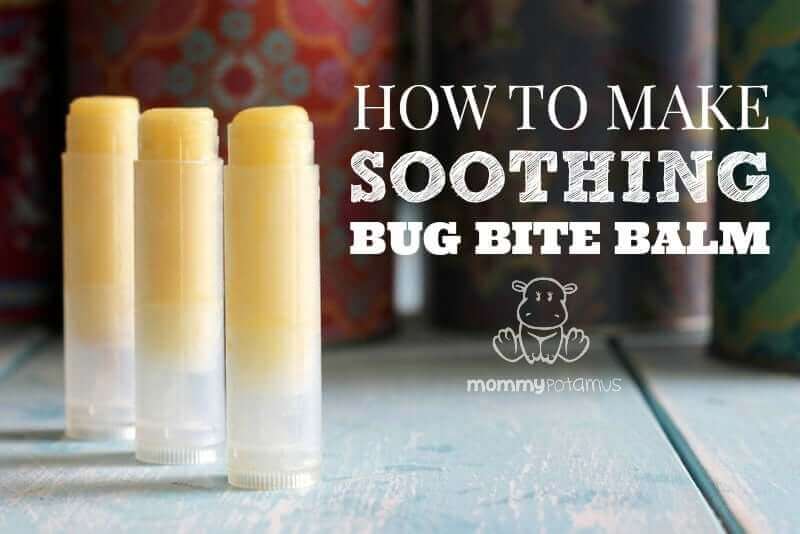
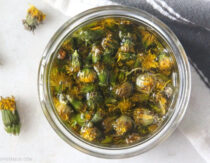

What to use instead of beeswax? The beeswax scent causes breathing problems. (Not wanting to use so-called ‘unscented’ beeswax either).
Thanks.
Hi Ken, you can use carnauba wax, but it’s harder than beeswax so you’ll probably want to decrease the amount used by about 20%. Here’s what I’ve used: https://www.amazon.com/Carnauba-Butter-Creme-Lotion-Candles/dp/B0155FDDPS/ref=as_li_ss_tl?ie=UTF8&linkCode=ll1&tag=mommypotamus-20&linkId=b16389c0e8c503b53d93458ffe0fd24a&language=en_US
Or try cocoa butter instead! It’s vegan, and also solid at room temperature like beeswax 🙂 you can add a tiny bit ignorant coconut oil to make it more soft too! Happy making 🙂
-purHealing
Do I have to dry the petals first or can I use fresh petals?
Love your DIY recipes and general information!
Elaine
Since this is so similar to the plantain salve, could you use both calendula and plantain to make one balm? Any benefit of both together, or are they better separate, or no difference? If you combine the herb oils, would you split it 50/50 in the recipe? Thanks!
I actually had the same question so would be very interested in the answer!
Also what about Comfrey Leaf/Root Oil?
I found a recipe that combines calendula and St. John’s wort infused oils . The author of Body Balance book states those herbal oil infusions compliment each other nicely and work well when mixed together.
The herbs and oils can be combined; I make separate herb oils then combine them for my ‘Good-for-anything-that-ails-you’ salve. I’ve seen it reduce scar tissue and I’m told it’s better than prescription hemorrhoid cream. Exception: arnica shouldn’t be used on open skin, so I would make it into a separate bumps and bruises salve. HTH
I ordered a pound of calendula and some carrot seed oil, I’m looking forward to making this recipe, I’ve never used either of these things so it will be fun to try. I appreciate that you gave the weight needed of beeswax, i have a big chunk and when i grate it it doesn’t always measure correctly so having the weight is very helpful. Thank you for all the information you give.
I made this salve with carrot seed oil and it’s fabulous! I just love it. I had a bite on my leg that wouldn’t get well and itched terribly, one swipe of salve and no more itching and it got well. I like the smell, it’s not strong but a very clean smell.
I made the calendula lotion yesterday and it turned out great, my first homemade lotion.
Thanks so much!
Can you use Argan oil?
Also, how much calendula flower (weight) per ounces of oil?
My sister has a really bad case of psyrosis on her leg. She itches it constantly. Do you think this would help? Thanks
it should as my granddaughter uses it , but she uses a spray daily as well , its made of 1 bottle of rice wine , 1 bottle of glycerin, 1 juice of a lemon. just mix it up and spray daily then rub in. then then follows the salve at night. best of luck and i hope you find relief .
Hello Heather I love your page. Have gained much info. Question can I use marigold potted in organic soil to make the Calendula Salve. Anxious to get started. Thanks for sharing all you have learned. Sandy
Being a bit dumb and not wanting to read between the lines…. You mention several oils in the recipe. Is it up to 50 drops of all of them combined or am I choosing just one?
Hey Janis, I know your question is old but hopefully someone else has the same question and this will help! It is a total of 50 Drops of any essential oils you use combined. So for example if you pick 3 different essential oils you wouldn’t use 50 drops of each- rather 50 drops combined. It sounds like a LOT, however, once any salve has set and firms up the scent of the essential oils gets much lighter. Enjoy lovelies! Thanks again Heather!
Thank you for this simple salve recipe! I actually used it with tea tree and peppermint oils, instead of Calendula oil. Next time, I intend to use lavender and chamomile oils as a “sleepy” salve I can use to calm down my normally rambunctious boy when he goes to bed
Hi Heather,
How did the sleepy salve go for your boy? I have been thinking of making similar for my grand daughter who finds it hard to relax and doesn’t like herb tea.
Hey there, I know this is an older post however the link for the calendula oil is a tracker link. I tried to click it and it sends you to some marketing software tracker site. Just curious what calendula you had recommended? Thank you 🙂
Can I reuse the flowers I’ve infuses once for anything?! Thank you!
Lovely recipe!
How long will it last for?
Hi there,
I make up to 20 20z. tins of Calendula salve at one time but I’m a little confused about the wax and oil ratio. I don’t want it to be too soft but not to hard either so the essential oil smell doesn’t come through.
Can you help clarify please.
Thank you!
Caroline
For me, the best ratio is 1 oz beeswax to 1 Cup infused oil.
Ive left the petals in the oil for 6 months :/ (completely forgot about the project!!) It looks fine, is it ok to use still, you think?
I’ve done the same thing. As long as the oil is still good IMHO i think we are fine. Let me know and I can let you know how mine turns out.
I would love to read the answers to these questions. Now that I have signed up for emails will it allow me to see the answers somewheres?
Thank you so much for your recipe! When I first read about it in your e-book I thought to myself that if the calendula works so then I can add other beneficial herbs to the oil to make the finished product even better for my own purposes. I am now making my own infused oils to make salves to help relieve my arthritic hands. I live in a “legal” state so I can add cannabis leaves to my infusion and using your cold infusion process I am guaranteed to get only the medically beneficial ingredients and not the psycho-active ones. I now get fast relief when I use this first thing in the morning on my old, arthritic hands.
Can I use jojoba or avocado oil instead of the calendula infused oil
Yes
HI Mommy
We are looking at using some Calendula Oil, for our little Moko, who has a serious nappy rash, which in places is actually an open wound… would that be okay?
Hi, really interested in making creams and salves. Can you point me in the right direction for a good book.
Is there a way I can use calendula tincture to make this salve?
i would like to make this but i am a little confused as to amount to use of the pre-made Calendula Oil i have a bottle that says 50ml but your recipe says 4 ounces
i have this one: https://www.amazon.co.uk/gp/product/B0013G6OL4/ref=ppx_yo_dt_b_asin_title_o06_s00?ie=UTF8&psc=1
but is the ounces by weight or by fluid
It’s by volume (fluid). I think because you’re on Amazon UK the listing is slightly different than the one available in the U.S.
30mls is one fluid ounce.
And American gallons are different to UK gallons – I asked Mr Google and apparently they were both the same once then UK changed their gallon measurement…way back when. Then again we use litres – well we do in Australia. When I left England some things were sold in kilos but material was still sold in yards. Has it changed now?
Re the gallon (but not really) it’s funny when you go to a new country with British traditions,some things are almost in a time warp whilst the old country has moved on : )
Sorry about this reply being so late but I only just found this site : )
Stay safe!
Been using this salve for 3 years now. It works 2 to 3 times faster than triple- antibiotic ointment for minor burns, scrapes. It removes the itch from any contact dermatitis, and also heals eczema. It’s safe to put a little inside dry, congested nostrils. Wonderful!
Do I have to dry the petals first or can I use fresh petals?
This is brilliant, going to start making the oil today then make a balm out of it…
How long would the balm keep for? I presume you can keep it at room temperature?
Hi. Thank you so much for this great recipe. So easy to make and only few ingredients needed. It is, by far, my favorite diy product. You can even adapt it to different needs with other infused oils or essential oils (sleepy salve, pain relief salve, headache salve, etc.). And like Heather mentionned, you can use it for multiple needs. I use it on every bobos that I have (burn, cut, bug bite…). I even use it on pimples. It really does help. I call it my MAGICAL SALVE.
I have rosacea for years now and I had some bumbs that comes out on my face recently. I tried to put that on and guess what? The bumbs are fading and seems to go away. I’m amaze that I can make products myself that can heal me!
I try to avoid products with comedogenic of level 3 and higher so this recipe is perfect; no coconut oil or cacao butter which are fairly high in the comegogenic scale.
I am so happy I came to find this lovely recipe; will make a batch for my family and friends for the Holidays. So easy and fun to do ♥.
Hi, I use so much calendula infused oil and chamomile infused oil (and now a new one for me…..dandelion). For skin treatments bruise, rashes cuts ….I’d like to make an infused oil of the two combined, an herbal infused oil made with calendula and chamomile flowers. What do you think?
That’s a great idea :
Hi Heather! Is there a way to make this salve using calendula tincture? Thanks 🙂
Tinctures are typically alcohol or glycerin-based which would not blend well with the oil/beeswax in this recipe, but I do have a recipe for calendula salve here.
Oh, I love this, and need to read it again! you have the basics laid out so clearly! Great job,
This is the recipe that got me started on infused topicals. Thank you so much! I now make a CCC salve that works wonders. The three C’s are calendula, comfrey, and CBD. Everybody who tries it loves it.
Once you strain the calendula flowers from the oil, how can you use the strained flowers?
I think that this could be useful on wet skin to SEAL IN the moisture on the skin but I don’t think that the salve itself is a moisturizer—it has no water…
Moisturizers contain water.
On the positive side, your site has a lot of great information. Thanks.
We absolutely love this salve for all of our skin issues! It is my favorite moisturizer, wonderful for eczema, bug bites, newborn skin, cracked nipples in the early weeks of breast-feeding… You name it! Thank you for such a simple and affective recipe.
I’m so glad you have found it helpful, Elizabeth. Thank you for taking the time to let me know!